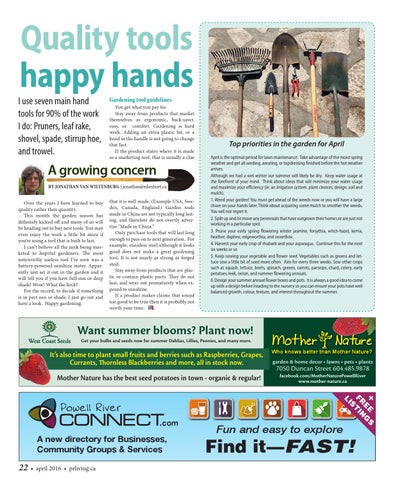Quality tools happy hands
I use seven main hand tools for 90% of the work I do: Pruners, leaf rake, shovel, spade, stirrup hoe, and trowel.
Gardening tool guidelines
You get what you pay for. Stay away from products that market themselves as ergonomic, back-saver, easy, or comfort. Gardening is hard work. Adding an extra plastic bit, or a bend in the handle is not going to change that fact. If the product states where it is made as a marketing tool, that is usually a clue
A growing concern BY JONATHAN VAN WILTENBURG | jonathan@edenhort.ca Over the years I have learned to buy quality rather then quantity. This month the garden season has definitely kicked off and many of us will be heading out to buy new tools. You may even enjoy the work a little bit more if you’re using a tool that is built to last. I can’t believe all the junk being marketed to hopeful gardeners. The most noteworthy useless tool I’ve seen was a battery-powered sunshine meter. Apparently just set it out in the garden and it will tell you if you have full-sun or deep shade! Wow! What the heck? For the record, to decide if something is in part sun or shade, I just go out and have a look. Happy gardening.
that it is well made. (Example USA, Sweden, Canada, England.) Garden tools made in China are not typically long lasting, and therefore do not overtly advertize “Made in China.” Only purchase tools that will last long enough to pass on to next generation. For example, stainless steel although it looks good does not make a great gardening tool. It is not nearly as strong as forged steel. Stay away from products that are plastic or contain plastic parts. They do not last, and wear out prematurely when exposed to sunshine. If a product makes claims that sound too good to be true then it is probably not worth your time.
Top priorities in the garden for April April is the optimal period for lawn maintenance. Take advantage of the moist spring weather and get all seeding, aerating, or topdressing finished before the hot weather arrives. Although we had a wet winter our summer will likely be dry. Keep water usage at the forefront of your mind. Think about ideas that will minimize your water usage and maximize your efficiency (ie: an irrigation system, plant choices, design, soil and mulch). 1. Weed your garden! You must get ahead of the weeds now or you will have a large chore on your hands later. Think about acquiring some mulch to smother the weeds. You will not regret it. 2. Spilt up and/or move any perennials that have outgrown their homes or are just not working in a particular spot. 3. Prune your early spring flowering winter jasmine, forsythia, witch-hazel, kerria, heather, daphne, edgeworthia, and sweetbox. 4. Harvest your early crop of rhubarb and your asparagus. Continue this for the next six weeks or so 5. Keep sowing your vegetable and flower seed. Vegetables such as greens and lettuce sow a little bit of seed more often. Aim for every three weeks. Sow other crops such as squash, lettuce, beets, spinach, greens, carrots, parsnips, chard, celery, early potatoes, leek, onion, and summer flowering annuals. 6. Design your summer annual flower boxes and pots. It is always a good idea to come up with a design before heading to the nursery so you can ensure your pots have well balanced growth, colour, texture, and interest throughout the summer.
Want summer blooms? Plant now! Get your bulbs and seeds now for summer Dahlias, Lillies, Peonies, and many more.
It’s also time to plant small fruits and berries such as Raspberries, Grapes, Currants, Thornless Blackberries and more, all in stock now. Mother Nature has the best seed potatoes in town - organic & regular!
Who knows better than Mother Nature?
garden & home decor • lawns • pets • plants
7050 Duncan Street 604.485.9878 facebook.com/MotherNaturePowellRiver www.mother-nature.ca
+ EE GS FR TIN S
LI
.com
A new directory for Businesses, Community Groups & Services
22
• april 2016 • prliving.ca
Fun and easy to explore
Find it—FAST!
